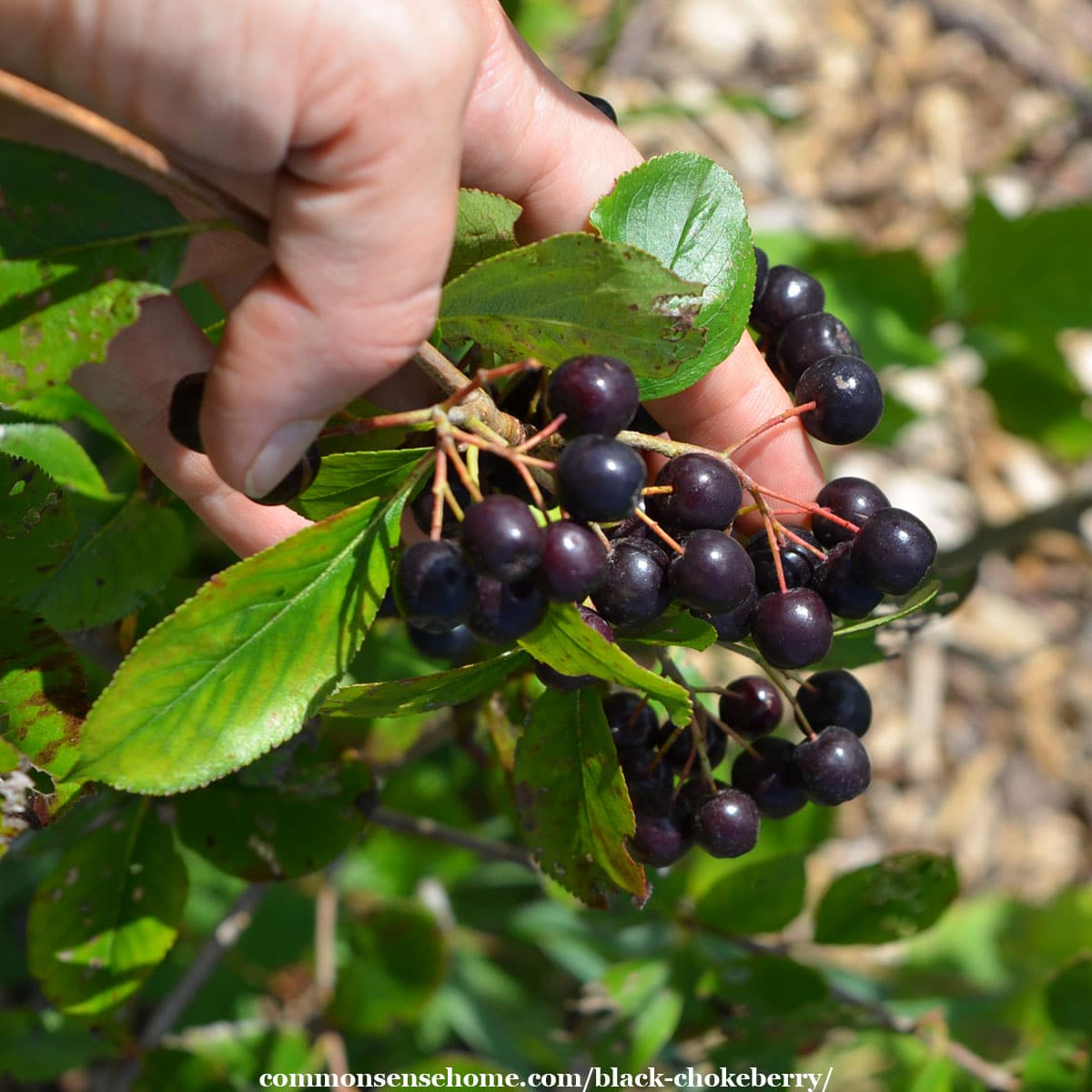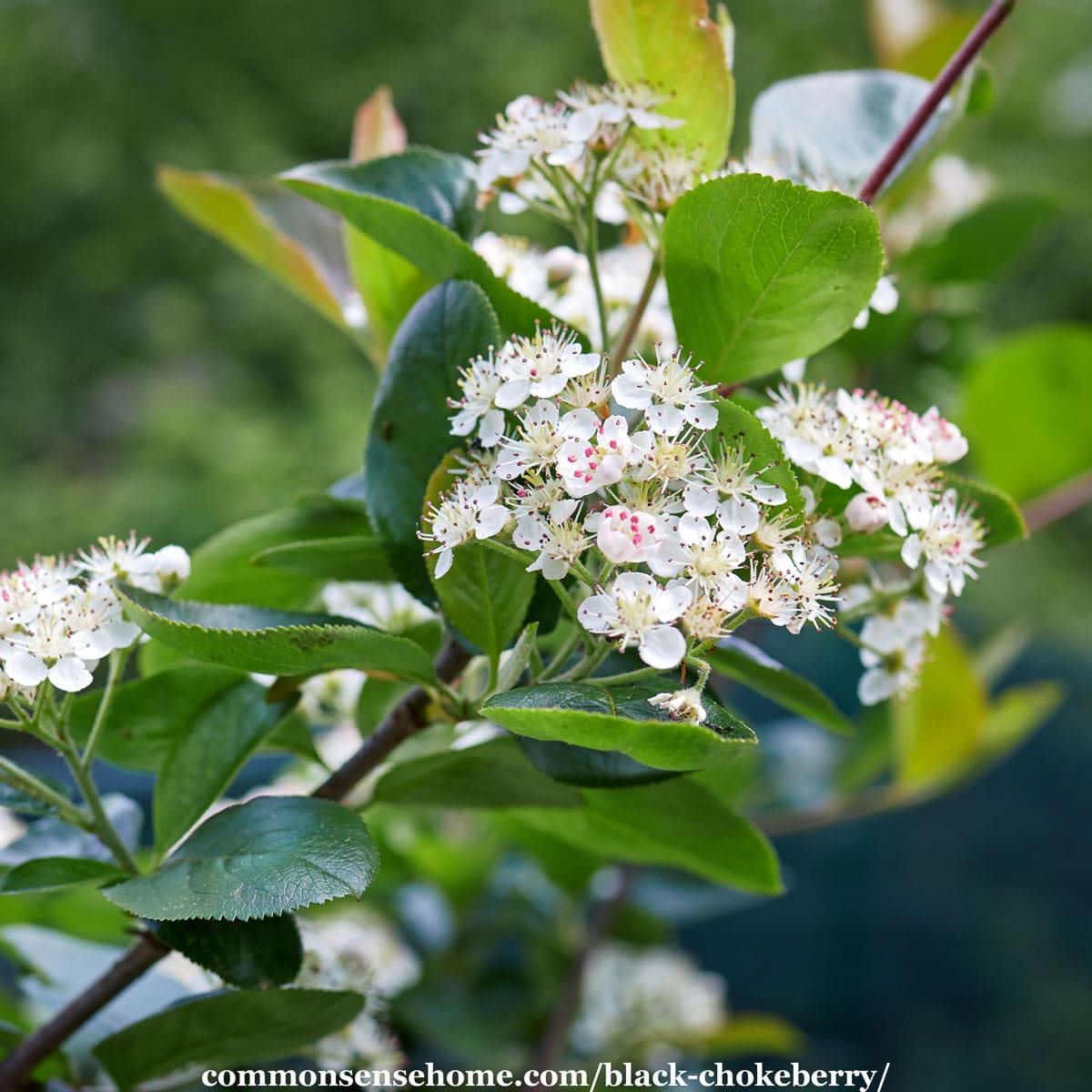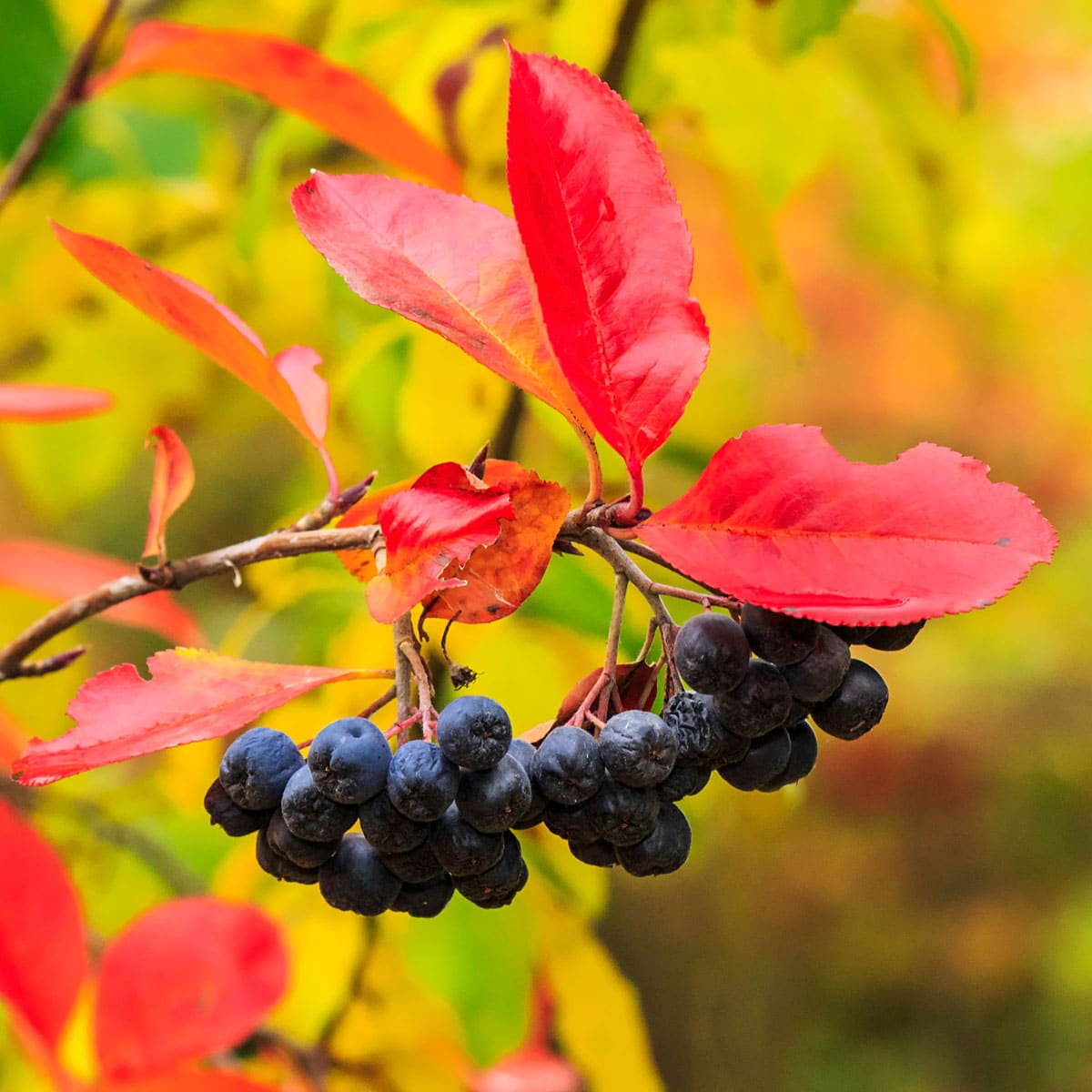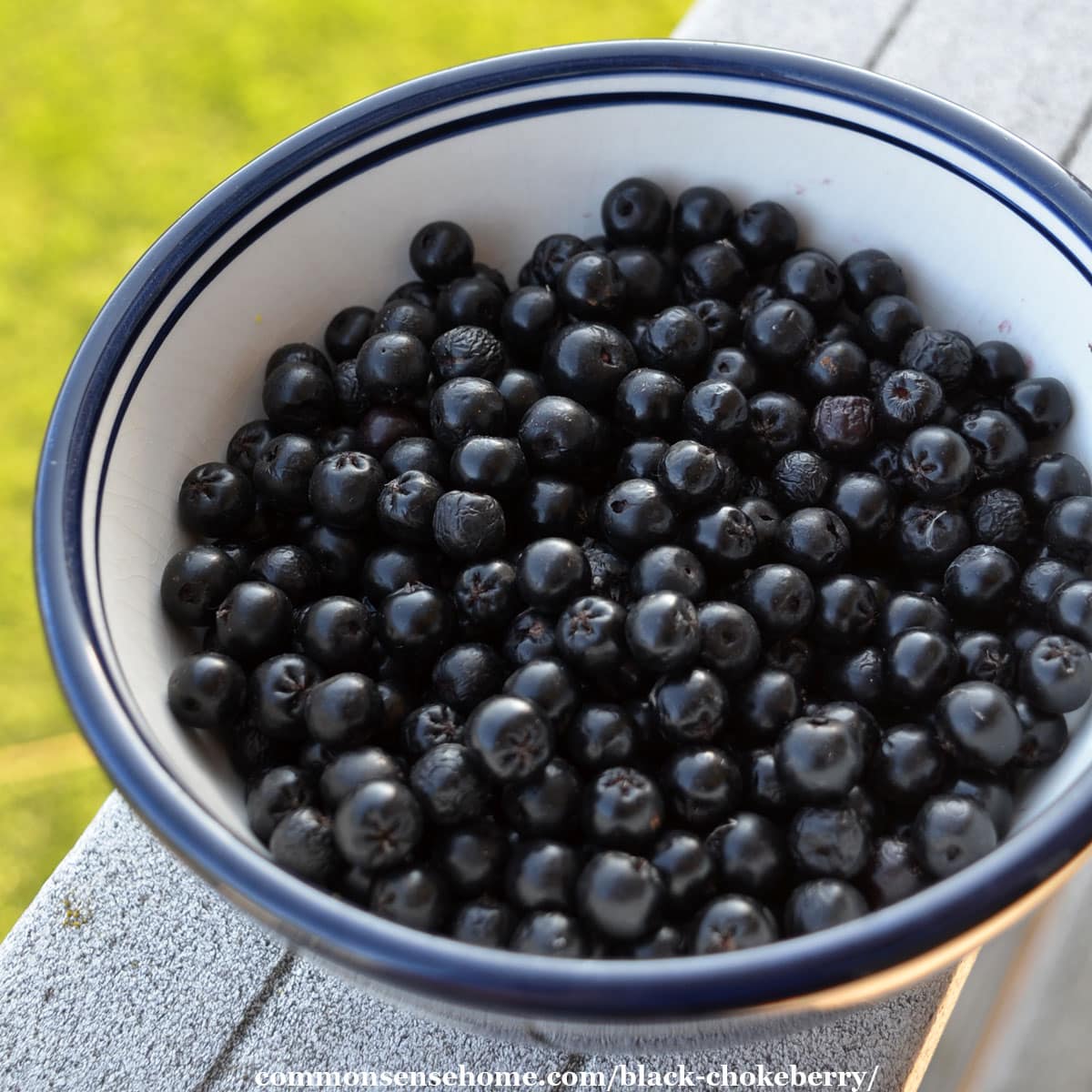Black Chokeberry – Aronia melanocarpa – Growing and Use
This post may contain affiliate links. Read my full disclosure here.
Black chokeberry (Aronia melanocarpa) is a deciduous shrub native to eastern North America. Largely ignored by foragers due to the astringent flavor, it’s gathered attention in recent years as a “superfood”. You may know them by another name – aronia berries.

With an ORAC value of 16,062, chokeberries have roughly four times the antioxidant capacity of blueberries. They even beat out elderberries impressive ORAC value of 14,697.
Once established, they’re easy to care for, and will provide fruit for many years to come. We’ll share what you need to know to grow this nutritional powerhouse, plus how to take the “choke” out of your chokeberries.
Chokeberry Quick Facts
The plants produce white flowers in spring, followed by purplish black berries in fall. It naturally spreads by suckers, which you can trim back or use to start new plants.
- USDA Planting Zones: 3 – 8
- Hardy to -30°F to -40°F (-40°C)
- Size: 2-8 feet tall x 2-6 feet wide (60.96cm – 243.84cm tall and 60.96cm – 182.88 wide) – size depends on variety
- Self-Fertile: yes
- Typical fruit production = 15-20 pounds per plant, depending on variety and conditions
- Plant Life: with proper care 20 years or more
- Sunlight: full sun recommended, but the plants can tolerate partial shade
- Watering: Drought tolerant, but watering ensures better fruit production.
- Years before fruit: 2 to 5 depending on variety, conditions and care.
- Soil: rich, well-draining slightly acidic, with a pH between 5.0 and 6.5
- Uses: Food, medicinal use and crafts
Planting Chokeberry Bushes
Chokeberries are typically found in wet soils with good drainage, like near the edge of a lake or swamp. They tolerate a wide range of soils, including sandy, loamy, or clay soils, as long as the soil has adequate organic matter.
For maximum fruit production, plant in full sun. They will grow in partial shade, but will not produce as much fruit.
- Choose a location with full sun to partial shade and well-draining soil that is rich in organic matter. Aronia berries prefer slightly acidic soil.
- Plant aronia berries in the spring or fall, spacing the plants 3-6 feet (0.9-1.8 meters) apart. If you are planting from seeds, soak the seeds in water for 24 hours before planting to improve germination.
- Dig a hole that is twice as wide and deep as the root ball of the plant.
- Mix in compost or other organic matter.
- Remove the aronia berry plant from the container and gently loosen any tangled roots.
- Place the plant in the center of the hole and backfill with soil, pressing down firmly to eliminate air pockets.
- Water well and mulch around the base to help retain moisture and control weeds.
- Prune back any damaged or dead branches and shape the plant as needed.
- Water the plant regularly, aiming for about 1 inch of water per week, especially during periods of drought.

Care
Use a layer of organic mulch, such as wood chips or shredded leaves. This helps retain moisture and suppress weed growth.
Deer, rabbits, mice, and voles will munch on the plants. We fenced ours to keep the deer at bay. New suckers come up each year to replace shoots damaged by voles during the winter.
Aronia berry plants are self-fruitful, but the bushes will have larger harvests and bigger fruit when cross-pollinated with another aronia cultivar/variety.
Prune chokeberries in late winter or early spring, before new growth appears. Remove dead or damaged wood, and thin out any crowded branches to improve airflow and sunlight penetration.
Naturalizing
One way to naturalize with chokeberries is to plant them in large groupings, and then allow them to spread and form a dense thicket over time. This provides habitat for wildlife, such as birds and pollinators.
Another way to naturalize with aronia berry plants is to plant them in mixed shrub borders or woodland edges. They also work well in wet areas, such as rain gardens. They can provide a nice contrast to other plants, with their dark green foliage, white spring flowers, and vibrant fall color.

The flowers are not a great nectar source for honeybees, but do provide pollen for bumblebees and other native pollinators. Birds eat the fruit, but like the red varieties better than the black.
Harvest
Aronia berries are ready to harvest in late summer or early fall depending on the variety. To determine if the berries are ripe, gently squeeze them or pick one off the plant and taste it.
If the berry is somewhat soft and has a sweet-tart astringent flavor, it is probably ripe. If the berry is hard and/or very sour, it isn’t ripe yet, and needs more time on the plant.
Use
In Nature’s Garden, Samuel Thayer shares his tip for getting rid of the chokeberry bitterness – he turns them into fresh juice. Since the pulp is the astringent part, when you remove it, you’re left with a much milder flavor.
Simply mix clean berries with some water, grind or smash, and then strain. He describes the flavor as a cross between tart cherry, grape, and blueberry. If you have a cider press, it works well straining the berries. (It will end up permanently purple in color.) Otherwise, you can use a jelly bag or tea towel for straining, or a sturdy juicer.
Would you like to save this?
Fresh juice has the mildest flavor. You can store berries in the refrigerator or freezer for later use. We’ve mixed aronia berries with elderberries in homemade elderberry syrup.

The berries are naturally high in pectin, so you can use them to make jelly without added pectin, like red currants. They’re also used in tea, jam blends, wine, and other recipes with work with their natural astringency.
If you have excess aronia berries, they’re safe to feed to chickens, ducks, goats, cattle and pigs. Use mixed with other feeds, since the seeds contain mall amounts of hydrogen cyanide, which can be toxic if consumed in very large quantities.
Chokeberry Health Benefits
Chokeberries have been used for centuries in traditional American Indian medicine to treat a variety of ailments, including inflammation, infections, and digestive issues. They are also high in fiber, vitamin C, and other nutrients.
Recent studies show potential benefits for cancer treatment, insulin resistance, and other chronic diseases.
Using Chokeberries in Crafting
The dark purple-black color of aronia berries makes them ideal for use in natural dyes for fabric and other materials.
- Natural dyes: The dark pigments in aronia berries can be used as a natural dye to color fabric and yarn.
- Potpourri: Add dried chokeberries to potpourri blends for their color and texture.
- Wreaths, centerpieces, and garlands: The small, colorful berries can be used to decorate wreaths and garlands.
- Soap making: Use powdered aronia berries or juice for natural soap colorants.
- Ink making: The dark juice of the aronia berries can be used as a natural ink.
Named Varieties/Cultivars of Aronia Berry
There are many named varieties of aronia berries that are cultivars of the two main species, black and red. These are a few common cultivars.
| Cultivar Name | Details | Species |
|---|---|---|
| Viking | Traditional Astringent | Black |
| Nero | Slightly Milder flavor | Black |
| Brilliantissima | Less bitter | Red |
| Autumn Magic | Sweeter, good fall colors | Black |
| Iroquois Beauty/Morton | Compact habit, fall color | Black |
| Low Scape Hedger | Shorter rounding | Red |
**Note the details for each variety will vary with the nursery. ALWAYS confirm with the nursery on zone, size, fruit color and any other details.
Other Names and Related Species
Black chokeberries are not the same as chokecherry (Prunus virginiana). Aronia melanocarpa was previously known as: Photinia melanocarpa, Pyrus melanocarpa, and Sorbus melanocarpa.
It’s closely related to Aronia arbutifolia, commonly known as red chokeberry. Purple chokeberry (Aronia prunifolia) is a natural hybrid of the other two.
Mountain ash or rowan, Sorbus aucuparia, is sometimes mistaken for chokeberry. It’s also in the rose family, and forms a tree or shrub. Native to Europe and Asia, it has naturalized through much of the United State and North America.

Related Articles
Shrubs, trees, and brambles add interest and value to the landscape. We have many different types in our yard and are constantly learning new ways to use them.
- How to Grow Elderberries for Food and Medicine
- Currants – Growing, Harvesting, and Uses
- Gooseberry Growing Tips, Uses, and Plant Varieties
- Harvesting Rose Hips for Food and Medicinal Uses
- Growing Blueberries – Best Tips for the Home Garden

This article is written by Laurie Neverman. Laurie and her family have 35 acres in northeast Wisconsin where they grow dozens of varieties of fruiting trees, shrubs, brambles, and vines, along with an extensive annual garden. Along with her passion for growing nutrient dense food, she also enjoys ancient history, adorable ducks, and lifelong learning.

There is a hedge of these black berries near one of the farmers markets near me. Last year I picked, or rather had my 6yo pick, 2 quarts while I was at the market. It kept him busy and gave me a project for later. Do you know if the seeds could be planted for starts? I’d be happy to seed some and try to start them so I can have some on my property. The birds don’t seem bother the bushes and the berries last a long time while staining the nearby sidewalk.
Hi Jerilea.
They can absolutely be propagated by seed, though of course it’ll take some time for the seedlings to size up. Official guidance from the USDA:
Great shirt, Laurie! We’re trying to get things growing here in the northern U.P. The soil isn’t great, more red sand than black dirt. I try to read your tips when they come in and hopefully I’ll remember when the time comes to plant. Thanks for the help!
The plants like organic matter, but they are quite forgiving. Ours are in the west orchard on the side of a small windswept hill, which is dryer than they prefer. The growing guide we got with ours didn’t mention their love of moisture (live and learn). They still keep chugging along with very little care. I am thinking about moving some suckers closer to the ponds to see how those perform by comparison, but there are so many other projects going on that it’s not a top priority.